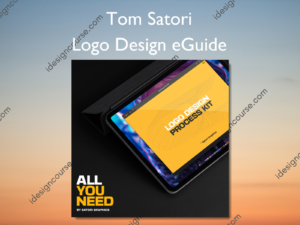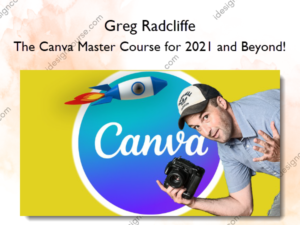Learn UX Design – Erik Kennedy
$995.00 $53.00
»Delivery: Within 24 hours from payment
Description
 Learn UX Design Information
Learn UX Design Information
Learn UX Design by Erik Kennedy is an online course that aims to teach individuals how to design intuitive and user-friendly web and mobile applications.
THIS IS A LONG WEBPAGE, SO I’LL SAY IT UPFRONT: only read this if you want to design intuitive and easy-to-use web and mobile apps, but you currently struggle to do so.
There’s a weird fact about human beings that people who make stuff often struggle to also make it usable. Developers are notorious for cranking out difficult interfaces. Graphic designers volunteer for their first UX project and think “so what exactly am I supposed to do here?” Try and Google around to answer these questions, and you’ll soon be reading about Fitt’s law and card sorting, and all kind of crap that – let’s be honest – UX designers basically never use. It might make for a nice article, but it’s not getting you any closer to making complex software simple and elegant.
It’s infuriatingly difficult to find the core ideas of making software usable. The principles that come up again and again. And yet those are the most important things!
This all gets even worse when you realize that many parts of designing good user experiences are already solved problems. Here’s an example. Say you’re making an email input field. Awesome – literally millions of people have entered their email address into billions of input fields. UX designers have been observing this for decades, and now, as a field, we just know the 20 or so most common pitfalls and pain points that bad applications have here.
Avoid those, and you have a wonderful little email input UX. It’s that simple.
The unfortunate truth is a whole lot of bad UX comes from not having a really big checklist. “Here are 50 things you’re just going to design at some point, and here are the 20 things to either (A) definitely do or (B) definitely not do for each”. That would have saved me some time in my own UX career!
Oh, and then there’s user research and usability testing. This stuff gets seriously blown out of proportion. I’ve had clients come to me concerned about not being able to do eye-tracking research on their MVP landing page. I’ve listened to otherwise competent professionals discuss about how many users need to be interviewed before comments are “statistically significant”. And the classic problem of teams who just “don’t have the budget for research”? Don’t get me started. (It’s like tax evasion: you may save a buck now, but you’ll have to pay eventually – and with interest)
These qualms about research and testing are all due to one common mistake: we’re overthinking it. We’re not trying to discover quantum gravity here, folks. We’re just trying to make our app suck a little bit less next week than it does this week. And fortunately, the most valuable research and testing doesn’t take an army of PhDs to perform. It’s simple enough that one person can do it in a day’s work. Of course, like any part of creating a great product, it’s never over. But fundamentally, there are a few things to get right – and a few pitfalls to avoid – but that’s the gist of it. It can all be done, no stats class required.
All in all, designing a great user experience is still a strangely difficult task. But you still want to learn anyways? Fantastic.
WHY UX DESIGN?
Everyone’s reasons for learning UX are a little different.
- Developers. You created your own app, but every time someone downloads it, they struggle to use it. And if your users are telling you this, then you know it’s really bad.
- Graphic and UI designers. UX is about the most natural skillset you can add to your career. Tons of employers need it – and are willing to give you a nice 5-figure salary bump if you can do it. Learning UX is a clear win.
- PMs. Your job is already like 25% UX designer. Would be nice to level up those skills.
- Entrepreneurs and hustlers. You’re already burning the candle at both ends to make your app a reality, but you know that if users find it frustrating and confusing, it won’t matter how many hours you put into it.
- Non-tech folks. You want a job in tech, but you don’t want to be a coder. That Psych degree better start paying for itself sometime, and UX is basically ergonomics of the mind. Time to level up.
There’s room for all of us here, by the way. Humans are pretty complex little lumps of emotions and values and wants and needs. Trying to design something we love? It’s fundamentally interdisciplinary.
And yet it’s so critical. Consider the following.
If your app technically solves 100% of your users’ problems, but is frustrating and confusing to use, your users will jump ship the first chance they get.
On the other hand, if your app is usable and delightful, even if leaves a couple features to be desired, your users will send you feature requests – with love letters for preambles. (Ask me how I know)
And at the end of the day, “I love your app and use it every day, but wish it did X” is a way better problem than “I deleted your app after an hour of trying to figure it out”.
In an ideal world, no software would need a manual. You’d just download it (or log in) and start using it. Features would be exactly where you looked for them, error messages – if you saw them at all – would be helpful and specific, and you’d never spend 5 clicks doing what could be done in just one. But what do you actually need to know to do this? How do you learn to think like a UX designer? How do you create something users will love?
Here’s what you’ll learn
- INTRODUCTION
- 1.1Begin Here
- 1.2Why Good UX Doesn’t “Just Happen”
- 1.3Overview of the UX Design Process
- 1.4Intro to Figma
- 1.5Intro to Sketch
- 1.6Setting Up Your Workspace for Rapid Wireframing
- 1.7Building a UX Reference Library
- THE FUNDAMENTALS OF INTERACTION DESIGN
- 2.1The Best Interaction
- 2.2Show What’s Actionable
- 2.3Think Like a User, Not Like a Database
- 2.4Jakob’s Law
- 2.5Obvious Always Wins
- 2.6The 3 Laws of Locality
- 2.7Mind your Nouns
- 2.8What Would a Polite Person Do?
- DESIGN PATTERNS & BEST PRACTICES
- 3.1Introduction
- 3.2Navigation and Menus
- 3.3Text Input Controls
- 3.4Selection Controls
- 3.5Errors
- 3.6Search & Filter
- 3.7Lists & Tables
- 3.8Browsing & Content Recommendation
- 3.9Responsive Design
- 3.10Accessibility
- USER RESEARCH & TESTING
- 4.1The Fundamental Dichotomy of Talking to Users
- 4.2User Research: Interviewing
- 4.3User Research: Surveys
- 4.4User Research: Personas
- 4.5User Flows
- 4.6Click-Through Prototyping
- 4.7Usability Testing
- COMMUNICATING DESIGN
- 5.1Creating a Design Portfolio
- 5.2Interviewing for Design Jobs
- 5.3Finding Clients
- 5.4Selling UX to Clients and Teams
- 5.5Presenting Your Designs & Getting Good Feedback
More courses from the same author: Erik Kennedy
Salepage: Learn UX Design – Erik Kennedy
Delivery Policy
When will I receive my course?
You will receive a link to download your course immediately or within 1 to 21 days. It depends on the product you buy, so please read the short description of the product carefully before making a purchase.
How is my course delivered?
We share courses through Google Drive, so once your order is complete, you'll receive an invitation to view the course in your email.
To avoid any delay in delivery, please provide a Google mail and enter your email address correctly in the Checkout Page.
In case you submit a wrong email address, please contact us to resend the course to the correct email.
How do I check status of my order?
Please log in to iDesignCourse account then go to Order Page. You will find all your orders includes number, date, status and total price.
If the status is Processing: Your course is being uploaded. Please be patient and wait for us to complete your order. If your order has multiple courses and one of them has not been updated with the download link, the status of the order is also Processing.
If the status is Completed: Your course is ready for immediate download. Click "VIEW" to view details and download the course.
Where can I find my course?
Once your order is complete, a link to download the course will automatically be sent to your email.
You can also get the download link by logging into your iDesignCourse account then going to Downloads Page.









